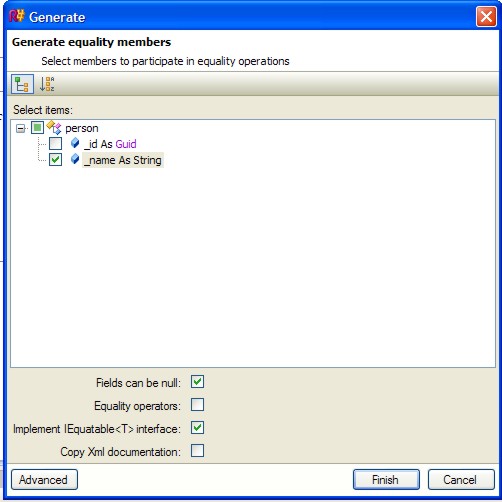Reshaper is a cool tool that can save you plenty of time (unless you start blogging about it of course ;-))
I will give the examples in VB.Net but this will also work in C#.
We all know what a DomainEntity looks like, right?
Ok so here is a simple example.
Public Class person
Private _id As Guid
Private _name As String
End Class```
First thing to do is create properties for it.
For this we use the [Reshaper][1] generate option, which is available via the shortcut **Alt+Ins** or via the menu **Resharper->Generate**.
This brings up the following contextmenu:
<div class="image_block">
<img src="/wp-content/uploads/blogs/DesktopDev/ResharperGenerate.jpg" alt="" title="" width="315" height="270" />
</div>
We choose Read-only properties:
<div class="image_block">
<img src="/wp-content/uploads/blogs/DesktopDev/ResharperGeneratereadonlyproperties.jpg" alt="" title="" width="501" height="499" />
</div>
And get this as a result:
```vbnet
Public Class person
Private _id As Guid
Overridable Public ReadOnly Property _idProperty() As Guid
Get
Return _id
End Get
End Property
Private _name As String
End Class
Not ideal, but a timesaver none the less.
We do the same but then as a normal property for name.
And get this as a result:
Public Class person
Private _id As Guid
Overridable Public ReadOnly Property _idProperty() As Guid
Get
Return _id
End Get
End Property
Private _name As String
Overridable Public Property _nameProperty() As String
Get
Return _name
End Get
Set (ByVal value As String)
_name = value
End Set
End Property
End Class
But now for the most important part. The overriding of the Equals and GetHashCode methods.
So we do Alt+Ins again and choose Equality members and get this dialog. We choose name and some other things that seem useful.

And we get this as a result:
```vbnet Public Class person Implements IEquatable(Of person) Private _id As Guid
Overridable Public ReadOnly Property _idProperty() As Guid
Get
Return _id
End Get
End Property
Private _name As String
Public Overloads Function Equals (ByVal obj As person) as Boolean
If ReferenceEquals (Nothing, obj) Then Return False
if ReferenceEquals (Me, obj) Then Return True
Return Equals (obj._name, _name)
End Function
Public Overloads Overrides Function Equals (ByVal obj As Object) as Boolean
If ReferenceEquals (Nothing, obj) Then Return False
if ReferenceEquals (Me, obj) Then Return True
If Not Equals (obj.GetType(), GetType (person)) Then Return False
Return Equals (DirectCast (obj, person))
End Function
Public Overrides Function GetHashCode() as Integer
If _name IsNot Nothing Then Return _name.GetHashCode()
Return 0
End Function
Overridable Public Property _nameProperty() As String
Get
Return _name
End Get
Set (ByVal value As String)
_name = value
End Set
End Property
End Class``` Cool, right, in a few clicks we got a whole lot of code. And a whole lot of working code to boot. It isn’t pretty, but there are things you can do about that.
There is also Formatting members which creates a ToString.
Which creates something like this.
vbnet
Public Overrides Function ToString() as String
Return string.Format ("_id: {0}, _name: {1}", _id, _name)
End Function
I don’t know who came up with the names but they should look at Eclipse, it is much clearer there. And the property names aren’t what I would expect, a return to hungarian comes to mind.




 Chris is awesome.
Chris is awesome.
